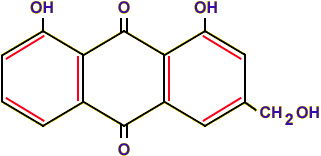In a recent review,
the results of antitumor assays of 379
anthraquinone derivatives were reported.
The authors concluded that “the most
noteworthy observation concerning the
anthraquinones is the relative lack of
activity among the numerous derivatives
tested from this group” (4). None were
found to inhibit the L-1210 leukemia in
mice, and only five showed some activity
against solid tumor systems. Aloe emodin
(NSC-38628) was among the derivatives which
were found to be inactive. Since the P-388
system did not number among the tumors used
in the study, our discovery of the
antileukemic activity of Aloe emodin may
reflect only a unique sensitivity of this
mouse leukemia toward the compound. We note
here, however, that the antileukemic
activity of Aloe emodin is particularly
vehicle-dependent, and that the
reproducible inhibitory activity toward the
P-388 system was manifested only when the
acetone-Tween 80 suspension was used. In
view of this fact, a re-examination of
other anthraquinones for potential
antitumor activity, with particular
attention to possible vehicle-dependence,
may be rewarded by the discovery of new and
useful structure-activity relationships.
ExperimentalExtraction & Fractionation
-
Ground, dried seeds of Rhamnus frangula L.
(1 kg) were extracted with ethanol-water
(1:1, 7 liters) at room temperature
overnight. The extract was filtered,
concentrated under reduced pressure to
about 1.5 liters and freeze-dried, to yield
163 g of residue. The residue was
partitioned between petroleum ether (2
liters) and water (2 liters), whereupon
13.5 g of solid remained undissolved and
was separated by filtration. Evaporation of
the petroleum ether to dryness under
reduced pressure yielded 11 g of residue.
The aqueous solution was extracted with
chloroform (2 X 2 liters), and evaporation
of the chloroform extract to dryness under
reduced pressure yielded 9.5 g of residue
(fraction A).
Chromatography
Of Fraction A -
A solution of fraction A (8 g) was treated
with 25 g of SilicAR CC-7. The suspension
was evaporated to dryness on a rotary
evaporator, and the residue was added to a
column of SilicAR CC-7 (500 g) prepared as
a suspension in chloroform. The column was
eluted first with chloroform (1 liter) and
then with 2.5% methanol in chloroform, and
30 X 100 ml subfractions were collected.
Subfractions were examined by tlc and those
which were similar were combined and
submitted for biological testing. The
aggregate of subtractions 17-25, all rich
in Aloe emodin (RF 0.54),
constituted the sole active fraction (B,
1.9 g).
Isolation Of
Aloe Emodin (1) -
Active fraction B (1.5 g) was crystallized
from chloroform-methanol, and
recrystallization from the same solvents
yielded orange-yellow needles (700 mg), mp
223-224o; lit. mp
223-225o (5). The melting point
was not depressed by admixture of an
authentic sample of Aloe
emodin5. Mixture tlc and
infrared spectral comparisons confirmed the
identity of the two samples.
AcknowledgmentsThis work was
supported by grants from the National
Cancer Institute (CA-11718) and the
American Cancer Society (CI-102), and a
contract with the Division of Cancer
Treatment, National Cancer Institute,
National Institutes of Health, Department
of Health, Education, and Welfare
(NO1-CM-12099). The excellent technical
assistance of Mrs. C. Marcks is gratefully
acknowledged.
Received 8 December 1975.
LITERATURE CITED
1. Kupchan SM 1976.
Novel plant-derived tumor inhibitors and
their mechanisms of action. Cancer
Chemother. Rep., in press.
2. Hartwell JL 1971. Plants used
against cancer. A survey. Lloydia
34: 103.
3. Geran RI; Greenberg NH; Macdonald
MM; Schumacher AM; Abbott BJ 1972.
Protocols for screening chemical agents and
natural products against animal tumors and
other biological systems (third edition).
Cancer Chemother. Rep., Part 3. 3:
1. Evaluation of assay results on a
statistical basis in sequential testing is
such that a material is considered active
if it causes an increase in survival of
treated animals (T) over controls (C)
resulting in T/C >125 percent.
4. Driscoll JS; Hazard GF, JR.; Wood
HB, JR.; Goldin A 1974.
Structure-antitumor activity relationships
among quinone derivatives. Cancer
Chemother. Rep., Part 2, 4(2): 1.
5. Karrer W 1958. Konstitution
und Vorkommen der organischen
Pflanzcnstoffe. Birkhaüser Verlag,
BaSel. p. 517.
1 Part 113 is reference
1.
2 Seeds of Rhamnus frangula
L. were collected in Austria in November,
1966. We acknowledge with thanks receipt of
the dried plant material from Dr. R. E.
Perdue, Jr., U.S. Department of
Agriculture, in accordance with the program
developed by the National Cancer Institute.
Voucher specimens are on deposit at the
Medicinal Plant Resources Laboratory,
Agricultural Research Service, Beltsville,
Maryland.
3 Antileukemic activity was
assayed under the auspices of the National
Cancer Institute, by the procedure
described in reference 3.
4 Melting points were
determined with a Mettler FP2 hot-stage
microscope. Infrared spectra were
determined with a Perkin-Elmer Hitachi
model 257 spectrophotometer as KBr pellets.
Petroleum ether refers to the fraction of
bp 60-68o. Thin-layer
chromatography was carried out on silica
gel 60 F-254 (E. Merck) precoated plates,
and chromatograms were visualized by
spraying with an anisaldehyde-sulfuric acid
spray; the developing solvent was 5%
methanol in chloroform.
5 We thank Professor H.
Wagner, Universität München, for an
authentic sample of Aloe emodin.
|
